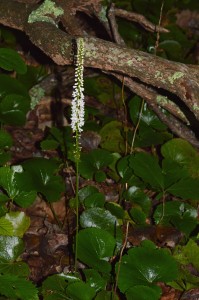Galax (Galax urceolata) is an under planted perennial wildflower native to the southern Appalachian mountains and eastern U.S. (USDA hardiness zone 5). Galax foliage is frequently collected from the wild for use in the winter floral decorations. Unfortunately, over-harvesting on public lands has jeopardized wild populations.
Galax grows 6 to 12 inches tall and is recognized for its dark evergreen glossy leaves which are round to heart shaped. The glossy round leaves of galax often turn a beautiful burgundy color in winter, particularly if weather is extremely cold and lacking in snowfall.
Galax is sometimes called “wandflower”. In late spring (June in SW Virginia, Western NC and East Tennessee) white flower spikelets emerge through the foliage on leafless stalks or “wands”.
The flower spikes, adorned with tiny white flowers, rise 9-12 inches above the dark glossy green foliage.
Galax grows best in cool, moist, well-drained, mildly acidic woodland soil. Allow galax 2 – 3 years to establish. Vigorous plants will slowly colonize and eventually form a dense carpet in your woodland garden. Long term success is built on soil moisture and not on how much you fertilize it. Mulching with pine needles helps to acidify soils over the years. Do not allow fallen leaves to smother the planting
Galax is a wonderful woodland ground cover and deserves greater landscape use. Deer will occasionally browse planting(s). Mt. Cuba Center in Greenville, Delaware recommends planting with Eastern teaberry (Gaultheria procumbens), Rosebay rhododendron (Rhododendron maximum), Mountain laurel (Kalmia latifolia), bellwort (Uvularia spp.) and crested iris (Iris cristata).


 Posted in
Posted in 
